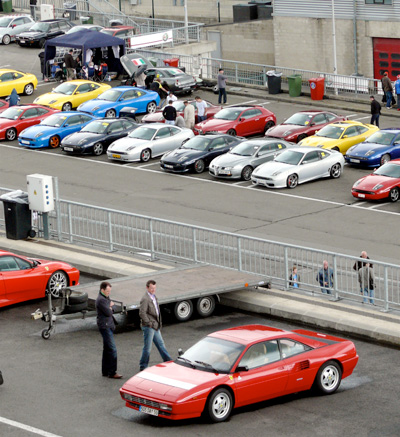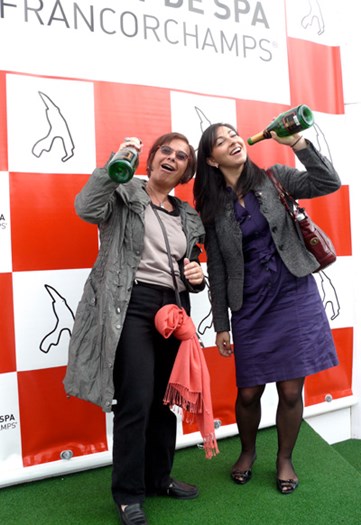SPA, BELGIUM – My heart begins to race as our driver points his mini-van in the direction of a long, narrow tunnel that separates reality from the fast-paced, romantic world of Formula 1 Grand Prix auto racing.
So many great motor racing stars have taken the trip though this tunnel that leads to Belgium’s legendary Circuit de Spa-Francorchamps – Michael Schumacher, Ayrton Senna, Jackie Stewart, Bruce McLaren, Jack Brabham, Jacques and Gilles Villeneuve …
Being the oldest track on the F1 circuit – it opened its gates in 1922 – Spa, as it is simply known in the racing world, holds many great memories for auto racing fans like me; and some bad ones, too.
It actually became infamously known as the “track of death” because it’s hair-raising design led to so many crashes, costing drivers, race marshals, and even mechanics their lives. It was scratched from the F1 calendar a few years ago because of safety concerns.
But it’s back now – by popular demand of F1 drivers - and the seven-kilometre-long beauty that cuts through the dense Ardennes Forest looks remarkable as we emerge from the tunnel into the paddock area.
The F1 drivers are nowhere in sight the June day we visit what is still regarded as the “fastest” course on the Grand Prix circuit. The Belgian Grand Prix is normally scheduled for August. However, the roar of engines is all around us.
“Spa has events 42 weeks of the year,” Luc Willens, the race track’s congenial press officer tells a group of tourists who are busy photographing a fleet of sleek Ferrari motors assembled outside the track’s massive main building.


Above: Race fans get to see some vintage race cars and act like GP drivers in the winner's circle.
“This weekend we are holding an Italian racing series event, so all the race cars must be Italian.”
Located just a few kilometres outside the famous wellness town of Spa, the Circuit has become as much as tourist draw as the town.
“We get at least 500,000 visitors a year (100,000 of those come to watch the F1 race alone),” says Willens.
The economic impact this track has on the region can be measured by how quickly the government responded to the track’s closing by F1’s governing body over safety issues in 2005. Without hesitation, the national and regional governments poured in over 11 million euros (about $18 million Cdn.) to bring the track up to standard.
“They may have spent 11 million euros but the track brings in between 60 to 70 million euros on the Grand Prix weekend alone,” Willens tells us as a group red, yellow and white Ferraris rev their engines in preparation for the start of the final race of the Italian weekend at Spa.
“When the track was closed many restaurants and hotels in the area either closed or went through much hardship,” says Willens, who quickly adds, that’s why they were so happy to see Spa reopen.”
Tourists can actually drive on the road course – with a professional driver at the wheel of a sports car - for about 100 eruos; for two laps.
“It’s every racing fan’s dream to drive on the same track that Michael Schumacher, Ayrton Senna and Jackie Stewart competed and we make that dream come true at Spa,” says Willens, a former auto racing journalist.
The hilly landscape on which the course is built is what makes the track so challenging. Because the forest limited what the original designers could do, most of the 21 turns are sharp and dangerous. Which is what F1 drivers, who reach speeds in excess of 300 km/h at Spa, love about this track.
Believe it or not, until a few years ago, part of the course made up a local highway. That all changed with the upgraded design.
The most famous part of the course is the Eau Rouge/Raidillon corner. Canada’s F1 driving champ, Jacques Villeneuve, whose famous father Gilles died on another Belgian track at the height of his great career, claims the Eau Rouge may be the toughest corner combination in Grand Prix racing. Few drivers would disagree.
As part of the upgrades to Spa, a new state-of-the-art media centre was built to accommodate the more than 500 journalists who cover the race each year.
Besides the F1 race, the other major event held at Spa each year is the 24-hour endurance race, which Willens says is just as popular as the Grand Prix weekend.
Very few F1 tracks open their doors to the public like Spa, which is just another reason to come to Belgium – a country that likes to live in the fast lane.
About the Author
Marc Atchison is a veteran journalist and a seasoned traveller with more than 20 years of travel writing experience. As the former Travel Editor of the Toronto Star, Canada's largest newspaper, and now Editor-in-Chief and Senior Writer for TraveLife magazine (Canada) and travelife.ca, Marc has been to over 100 countries in the world. Japan is one of his favorite destinations and he's been there on numerous occasions.